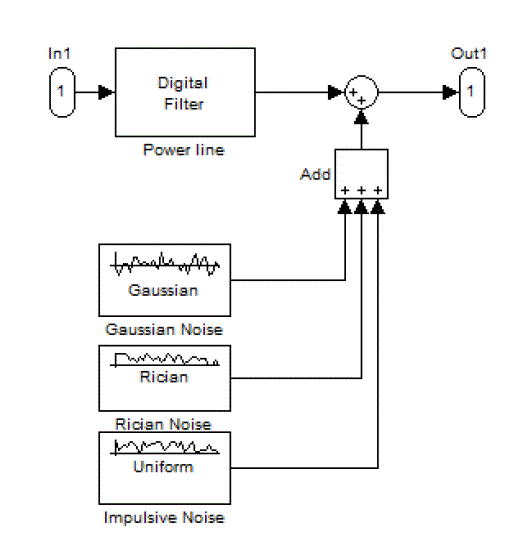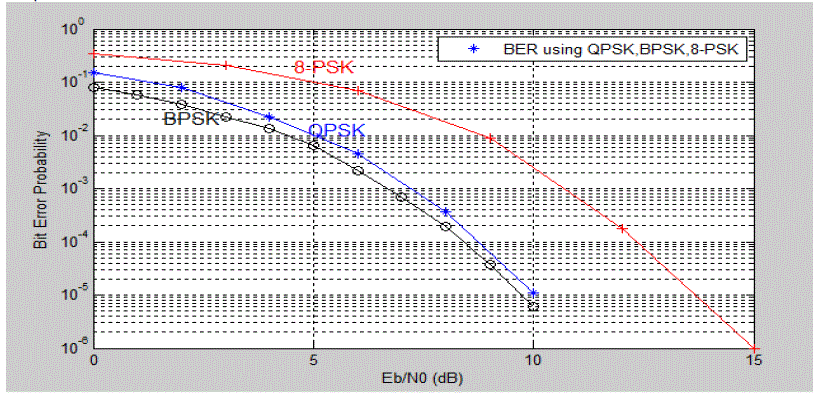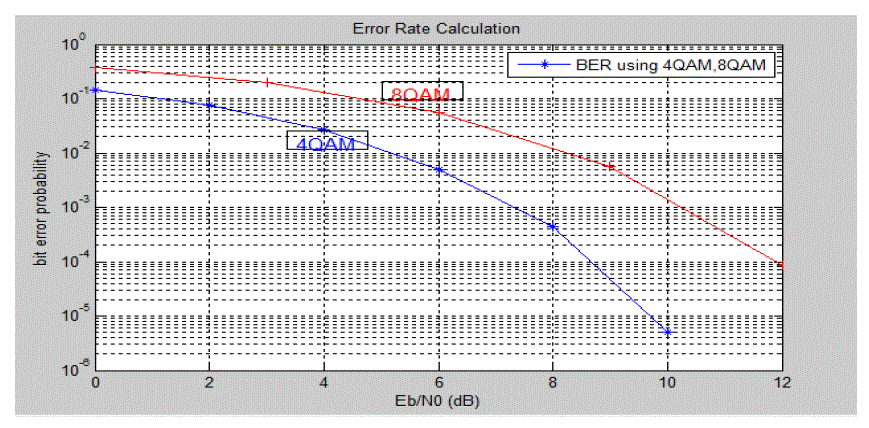Power Line Communication has been considered as a good candidate for “the last mile” solution and for home networking. However Power line is worse than other wired transmission medium due to its noise. This paper introduces power line channel modelling and to realize reliable data communication over PLC. This paper carries the first Power line Channel properties and noise behaviour. This paper discusses required techniques and basic knowledge in power line communication. Hence, information on how the concept of digital modulation scheme are introduced, how data will transmit through power line.
Keywords |
| Power Line Channel, Digital Modulation Techniques, BER |
INTRODUCTION |
| Power line Communication Carries a data on conductor that is also used simultaneously for AC electric power
transmission or electric power distribution to consumers. It is also called power line carrier [1]. The PLC technology
(Power Line Communication) uses a Power Line for data communication. PLC Technology takes profit from the
advantage of not requiring any additional wiring. Power lines were originally devised to transmit electric power from a
small number of sources to a large number of sinks in the frequency range 50-60Hz [2]. |
| The main advantage of PLC is the use of an existing infrastructure. The PLC communication takes place over the same
lines that deliver electricity. This technique involves injecting a high frequency over AC carrier onto the power line and
modulating this carrier with data originating from the remote meter or central station. Power line carrier techniques are
used successfully and cost effectively for short distances [1]. |
RELATED WORK |
| The basic principle of power line communications (PLC) is to use the existing electrical power line networks for
telecommunication purposes. Over the years, power line networks have served as a medium of transmission and
distribution of electricity signals. Until recently, communication over power lines was restricted to low-speed functions
such as remote metering and operations management that serve the needs of power supply utilities. This limited scope
of power line functions changed recently, on account of the tremendous demand for high-speed broadband multimedia
communications. |
| A survey of the literature surrounding PLC is provided in this chapter. Undoubtedly, knowledge of the structure and
properties of power line networks is essential for the examination and development of new PLC techniques and
products. The historical development and the current advances in the PLC technology are outlined. Details about the
contending modulation techniques and channel modelling methods are also provided. This chapter serves as a
knowledge basis that will be used in later sections of the dissertation to investigate existing techniques and develop new
ones to serve the aim of enhancing the performance of PLC systems. |
| In [2] author analysed asynchronous noise in PLC system Using OFDM (Orthogonal Frequency Division
Multiplexing). In this paper, the OFDM sub carriers are modulated using BPSK, 4-QAM and 16-PSK. OFDM
performance analysis, for PLC system and under different sub-carriers modulation, has been carried out. In [3] author
analysed and simulates the noise model in power line communication systems. They have discussed various aspects of
PLC in this paper. It can save infrastructure cost such as installation of fibre optic cables and can reach to rural areas
since the power line infrastructure is already present. Then the nature of PLC as a communication environment was
analysed. In [4] author presents the study of the UWB (Ultra Wideband) transmission characteristics over household
power line in a very high frequency band, from 50 MHz to 550MHz. The characteristics of indoor power line channels
are examined for its use in UWB Communication in both measurements and software simulations. Firstly, broadband
channel characteristics are measured in both frequency and time domain, followed by system level simulation of BER
performance versus Eb/N0. |
PROPOSED ALGORITHM (POWER LINE CHANNEL) |
A. Power line Transfer Function |
| Power line network, whose original design is not intended for data communication, shares some similarity to other
wired networks, such as Ethernet and telephone local loop. Modelling the power line channel is tough task since its
nature is unpredictable nature with frequency, time of day, geographic location and rural environment. The main
parameters, taken into account are the impedance, attenuation and noise. Absolute impedance of the power distribution
system up to 30 MHz has been carefully studied in several countries. A component model can be expressed by F matrix
shown in equation [9]. |
 (1) (1) |
| Where A, B, C, D are the coefficient of F matrix. V1, I1 are input Voltage and input current. V2, I2 are output voltage
and output current. All the coefficients are uniquely defined from an equivalent circuit model and coefficients can be
mentioned as the model parameters of the component model by using two port models all the parameters can be
calculated by the equation from [9]. |
 (2) (2) |
 (3) (3) |
 (4) (4) |
 (5) (5) |
| And the transfer function can be given as, |
 (6) (6) |
| Whereγ is propagation constant of the power line. Rs, R1 are source and load resistance of the power line and 1 is the
number of concentrating node in the transmission or reception side. |
B. Power line model |
| The power line model is required to simulate PLC communications. The power line model applies the methods used to
model electricity distribution networks. The chain parameter matrices describing the relation between input and output
voltage and current of two-port network can be applied for the modeling the transfer function of power line channel
[10]. |
| Modeling power line as cascaded elementary two-port network enables working with elementary networks, two-ports,
which can be described by cascade parameters. Cascade solution offers the possibility of choosing a certain degree of complexity and precision of the line being modeled. It is also possible to define individual blocks as macro models
describing a data channel [10]. |
| Each part of the line is described by a separate cascade matrix A1 to A4. Internal series impedance Zs of signal source Vs
and parallel impedance of load ZL can also be described by cascade parameters and included in the resultant transfer
function. The power line model with noise model is shown in fig 2. The particular noise has been created by Simulink
block’s help [10]. |
C. Power line channel conditions |
| The main problem associated with PLC is Channel noise. The Channel noise is mainly non-white in nature. There are
various types of noise that need to be taken into consideration while designing a PLC system. They are listed as follows
[2]. |
| 1. Background Noise: Mainly low power noise that vary slowly over time. |
| 2. Narrowband Noise: Mainly Confined to a narrow portion of the Channel. Depends on atmospheric conditions. |
| 3. Periodic Impulsive Noise: Mainly caused by switching power supplies and also due to supplies synchronous
with the main cycle. |
| 4. Asynchronous Noise: Mainly caused due to switching transients. The noise is the most severe in nature. |
SIMULATION RESULTS |
| The Simulink model has been made from using power line channel as medium to transmit digital data using digital
modulation techniques in MATLAB using simPower tool. The simulation studies the performance of the power line
according to the BER it is calculated by SNR vs. Eb/N0 reading. Here proposed system is basic digital modulation
system using different modulation techniques like BPSK, QPSK, 8-PSK, 4-QAM, and 8-QAM. In comparing
performance of three PSK based transmission under same channel (PLC) Condition, three BER plots are generated for
each channel conditions. In theoretical probability of error for M-PSK is calculated by: |
 |
|
| The mathematical analysis and simulation using SIMULINK shows that BER for all the M-ary PSK based digital
modulation schemes decrease monotonically with increasing values of Eb/N0.
To calculate probability of error in M-QAM (theoretical): |
 |
|
CONCLUSION AND FUTURE WORK |
| The simulation results showed that the performance of digital modulation techniques using Power line channel is better
performance for the transmission of digital data. Power Line Communication is one of the technologies that have
proved useful for control application. It is widely used in home automation, automotive and internet access application.
The performance of digital modulation techniques is calculated from BER. BER is a parameter which gives excellent
indication of the performance of digital modulation techniques for digital transmission systems. Here BER is as low as
10^-4 indicates the better performance using PLC channel. Simulation of power line in MATLAB have checked
transmitting frequency over 50-60 Hz for the medium of digital transmission. |
| In future we can use modulation scheme and coding techniques for high speed data transmission up to 10Mbps using
power line channel as a medium. |
|
Figures at a glance |
 |
 |
 |
 |
| Figure 1 |
Figure 2 |
Figure 3 |
Figure 4 |
|
References |
- Muhammad Salman Yousuf, Mustafa El-shafei, 2008 IEEE ?Power line communication: an overview part1?
- Srikrishan Jagannathan, Aldo Morales, and Sedig Agili, ?Performance of OFDM-based Power Line Communication under Asynchronous Noise? 978-1-4799-1291-9/14/$31.00 ©2014 IEEE
- Mr. Ravindra P. Joshi, Mrs. Sahana Bhosale, Mr. Prakash H.Patil, ?Analysis and Simulation of Noise in Power Line Communication Systems?978-0-7695-3267-7/08 $25.00 ©2008 IEEE
- Shuxian Chen, Xiaodong Chen, Clive Parini, ?Measurement And Simulation of Power Line Channel using OFDM for UWB Communication?,978-1-4244-3790-0/09/$25.00 ©2009 IEEE
- Matthias Gotz, Manuel Rapp, and Klaus Dostert, ?Power Line Channel Characteristics and Their Effect on Communication System Design ?,0163-6804/04/$20.00 © 2004 IEEE
- Y Gao, E Liu, O Bilal, TO Korhonen, ?Channel Modeling And Modem Design For Broadband Power Line Communication? ISPLC2004
- Petr mlynek, jiri misures, martin koutny, milos orgon, ?Power Line Cable Transfer Function for Modeling of Power Line Communication System?, Journal of ELECTRICAL ENGINEERING, VOL. 62, NO. 2, 2011, 104?108.
- Matthias Karl,Klaus Dostert, ?Selection of an Optimal Modulation Scheme For Digital Communications Over Low Voltage Power Lines?, 0- 7803-3567-8/96/$5.00 0 1996 IEEE
- M.Shukla, Nutan Sharma, Shashi Tiwari, ?Performance analysis of Iterative IDMA scheme in Power line Communication using Random Interleaver?, Vol.3, No.3, 2013- National Conference on Emerging trends in Electrical, Instrumentation and Communication Engineering
- P.Mlynek, M.Kounty, and J.Misurec, ?Power line modeling for creating PLC Communication System? International Journal of Communication, Issue 1, Volume 4, 2010.
|